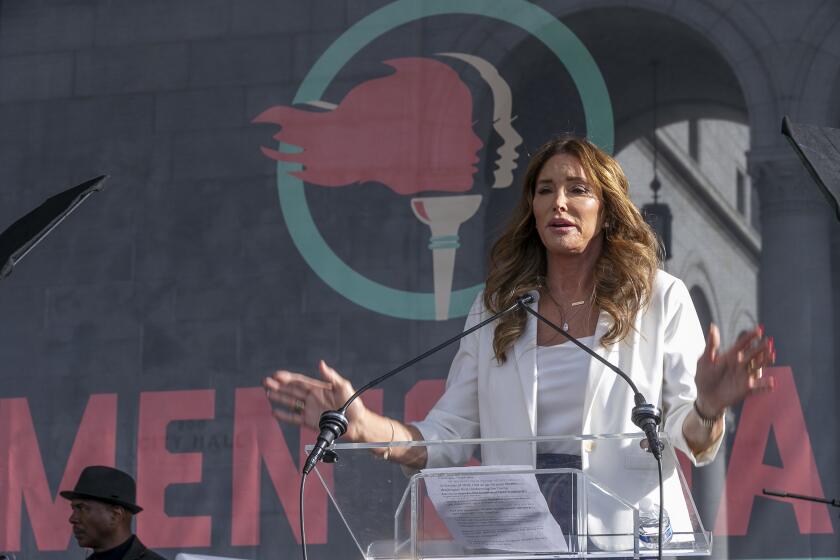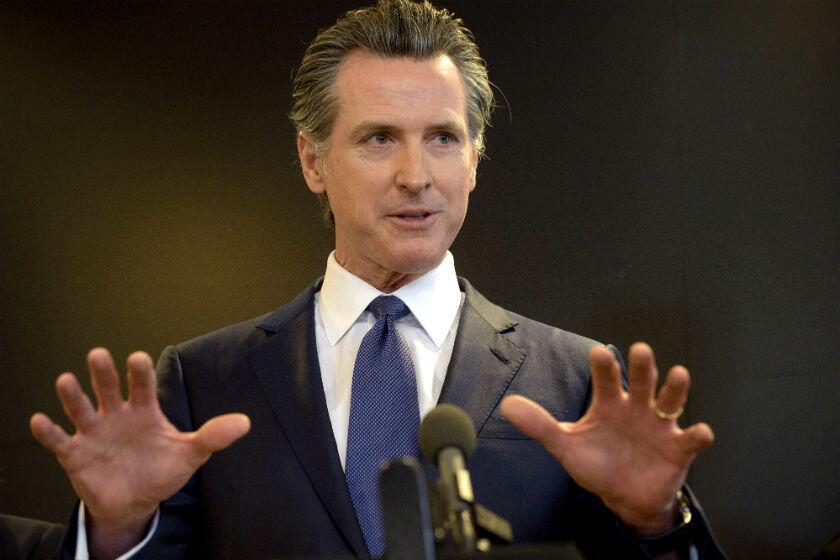Column: The Atlantic says ‘the California Dream is dying.’ So what else is new?

- Share via
Magazine writers’ chestnuts don’t get any more dependable than the “death of the California dream” trope.
It’s got everything a writer looking for buzz could ask for: the irresistible opportunity to simultaneously evoke and denigrate the sun and fun of the Golden State.
Bikini-clad prurience and quelling of readers’ enviousness in one glittering package. Hollywood glamor, Silicon Valley wealth and the dark side of both, all at the same time.
If California fails to offer young people and newcomers the opportunity to improve their lot, the consequences will be catastrophic—and not only for California.
— Conor Friedersdorf, The Atlantic
“You were right to scoff,” the authors assure their readers. “California is just as bad as the place you live in.”
No wonder that articles flogging this theme appear so regularly, every six months or so, that you can pre-fill your iPhone calendar app years in advance to notify you that the next one is on its way.
Get the latest from Michael Hiltzik
Commentary on economics and more from a Pulitzer Prize winner.
You may occasionally receive promotional content from the Los Angeles Times.
The latest installment comes to us from the Atlantic, an 8,000-word piece titled “The California Dream Is Dying.”
Its author, Conor Friedersdorf, is a Californian himself. That sets him apart, at least, from the customary authors of similar screeds, visitors from outside parachuting in for a week or two to sponge up local color for their takes.
Friedersdorf, however, follows more or less the same course as many of the others. Like them, his mood is both elegiac and apocalyptic.
“California has always thrived by embracing both cultural and economic dynamism,” he writes. But “if California fails to offer young people and newcomers the opportunity to improve their lot, the consequences will be catastrophic — and not only for California.”
As I’ve observed in the past, the literary genre of California truth-telling dates back to the mid-1800s. The earliest version I’ve found was published in 1855, in only the fifth year of California statehood, by one Hinton R. Helper, a transplant from North Carolina who cursed the state’s “rottenness and its corruption, its squalor and its misery, its crime and its shame.” (Helper wasn’t wrong.)
Five years later, Horace Greeley, famous for having counseled young men to “Go West,” warned that California was almost tapped out as a land of opportunity.
“No more merchants or clerks are wanted,” he wrote; “and of those who come hereafter, nine-tenths will go back disappointed or impoverished, or stay here paupers.”
The California recall seems to be commanding the attention of people everywhere, except in California.
Friedersdorf isn’t wrong about many of the maladies facing the California dream today. He cites an anti-growth mentality by residents that causes a lack of affordable housing, conflicts over water, deteriorating roads and other infrastructure and government regulation.
All these features do exist in California, though some of the complainants Friedersdorf quotes are plainly engaged in special pleading. That includes an almond farmer in the Central Valley who grouses that the average Californian doesn’t understand what he does for a living or how much his crop contributes to the state.
Um, no: The problem with the California almond crop isn’t that people don’t understand it but that almond trees’ demand for an uninterruptible water supply is less and less consistent with the availability of water as the state’s drought deepens and global warming threatens to make it even worse.
Friedersdorf mentions the grower’s fallowing of land and bulldozing of almond trees because of drought but doesn’t explore how the competition for ever-scarcer water shapes the state — and not necessarily for the worse — beyond that. Among other things, the state is a national leader in water conservation.
Overregulation? Friedersdorf quotes business owners complaining they’ve been cited for violations. (My guess: A poll of such business owners would turn up unanimous agreement that regulation is bad.) But he denigrates the state’s landmark California Environmental Quality Act by citing how it interferes with the addition of bike lanes on public roads.
This is a woefully skewed picture of CEQA, which was enacted in 1970 in the aftermath of the Santa Barbara oil spill, a genuine catastrophe. Friedersdorf calls CEQA “vulnerable to abuse,” by which he means that it’s exploited by locals to block environmentally suspect projects.
But he doesn’t mention that it’s also vulnerable to political pressure by well-heeled developers, like the developers of big NFL stadiums who received exemptions from CEQA rules they claimed were onerous.
A new survey concludes that California is most anti-business state, but it can’t explain why it’s also the fastest-growing.
He cites surveys by CEOs and business lobbies ranking California’s business environment as the worst in the nation. I’ve reported many times on the folly of relying on similar surveys to gauge the strength of the state’s economy, since they consistently fail to explain how such an anti-business state can show the nation’s strongest economic growth. Maybe they’re just baloney.
Friedersdorf, to his credit, shows that he is well aware that California’s history is nothing like a steady march to diversity and opportunity for all. “Across its first century, California kept attracting fortune seekers both foreign and domestic, its population always growing,” he writes, before acknowledging “California’s many failures to do right by its wildly diverse inhabitants.”
As he reports, the Gold Rush led to genocidal attacks on native tribes. The importation of Chinese labor for the Central Pacific Railroad led to the Chinese exclusion laws. Development of farmland by Japanese settlers led to statewide discrimination against the Japanese and ultimately to their wartime incarceration, one of the most unpardonable episodes in California, and American, history.
The state’s relationship with Latino and Black residents has been punctuated by outbreaks of violence, some of it directed at ethnic minorities and some of it the expression of minorities’ frustration with social inequity: the Zoot Suit riots of the 1940s, the 1965 Watts riot, the 1992 Los Angeles riots after the Rodney King verdict.
The fundamental problem with Friedersdorf’s piece and many like it is a problem of framing. By implying that something new has arrived to derail the California dream, he implies that the state was strutting high, wide and handsome until very recently, when it ran into a brick wall and the dream was blown to smithereens by encroaching reality.
California turned anti-Chinese and anti-Japanese sentiment into a national movement.
He mentions the report in May that the state had experienced a net loss in population during the pandemic. Evoking Carey McWilliams, the California historian whose 1949 paean to the state identified it as “the great exception,” Friedersdorf writes that the shrinking of the state’s population is something “McWilliams would have found unthinkable.”
That’s surely incorrect. McWilliams in his book made clear that California was a work in progress and could veer off into any direction: “The time has not yet arrived for a real summing-up; one cannot, as yet, properly place California in the American scheme of things.... There is still too much commotion — too much noise and movement and turmoil.”
McWilliams also warned that “California’s resources are basically inadequate to support its future population.” Rather than finding a population break “unthinkable,” McWilliams saw it as very, very plausible.
What “the dream is dead” theme overlooks is that California has always been a place of boom-and-bust economics, of shifting political ideologies and of contradictions of all sorts. It’s seen today as a beacon of progressive politics, as it was at the turn of the last century; but between those bookends it also gave us Richard Nixon and Ronald Reagan.
Favorite son Earl Warren ranks as one of California’s most liberal governors and became an avatar of racial justice as chief justice of the U.S.; what’s almost universally forgotten is his virulently racist advocacy of Japanese incarceration during the war.
“When we are dealing with the Caucasian race we have methods that will test the loyalty of them,” Warren advised a congressional committee pondering the policy, “but when we deal with the Japanese we are in an entirely different field.”
Some of what Friedersdorf identifies as California ills are obviously maladies of American society as a whole. He tells how his grandfather, a carpenter, was able to buy a house, settle in Orange County and raise a family of four as his household’s sole breadwinner in the 1950s.
California remains a powerhouse, but demographic and economic data do raise some worries.
“At 41,” he writes, “I’d be hard-pressed to buy a home in the neighborhood where my grandfather built his house and where my parents bought theirs three decades later.” That may be so, but the hollowing out of the American middle class and the difficulties of achieving home ownership, not to mention college tuition and retirement, is not merely a California phenomenon but a national one.
It’s fair to say that California, for all its strengths, isn’t immune from the inequality of the American economy, but is that a rap against the “California dream”?
Every virtue of California from its statehood to its astonishing postwar growth was sure to inspire a reaction; it’s hardly unusual for people who have climbed the ladder of economic success to try to pull it up behind them. California residents who settled in desirable neighborhoods have fought to keep them as they were at the start. But the not-in-my-backyard impulse isn’t unique to the Golden State.
Californians confronted extremes of water and air pollution and responded with some of the most stringent pollution regulations in the land. To some of Friedersdorf’s sources, this is a burden. But the state’s methods of controlling pollution have become models for dozens of other states, so there must be some good to them.
To say the California dream is dead or dying is still at least somewhat of an exaggeration. The population decline is properly blamed on the pandemic and is more than likely to reverse soon. The state’s median household income of $75,200 handily exceeds that of states whose reactionary governors love to point to California as a failure: Texas, $61,870; Florida, $55,660. Until the recent Delta variant-driven surge in COVID cases, California’s new case rate was the best in the country.
Critics assert that California is “hemorrhaging people,” but this is not a new phenomenon — California has lost population to other states every year for the last three decades; the issue is who’s leaving and who’s arriving? The answer is that it still sees net in-migration of those with advanced degrees, the highest incomes, and the young.
So, yes, in a sense the California dream is dying, but it has been dying almost since it was born. Friedersdorf shows an acute awareness of where the threats to the state’s future lie, as he should, being a Californian with the incisive awareness of the outside world of any good journalist.
But somehow, the state is still showing the rest of the country, and the world, how to survive and even thrive in the face of the harsh realities around us. Maybe the next iteration of the “California is dying” trope will get it right.
More to Read
Inside the business of entertainment
The Wide Shot brings you news, analysis and insights on everything from streaming wars to production — and what it all means for the future.
You may occasionally receive promotional content from the Los Angeles Times.













